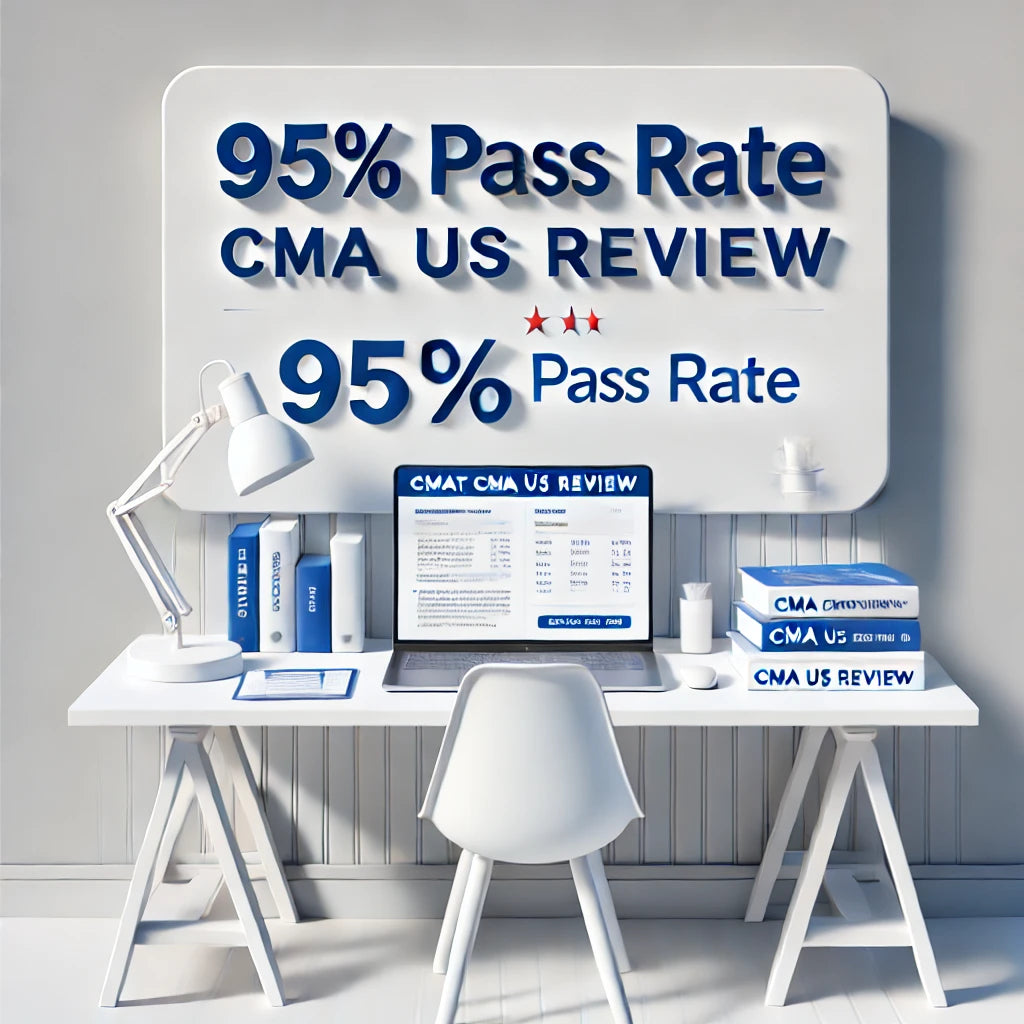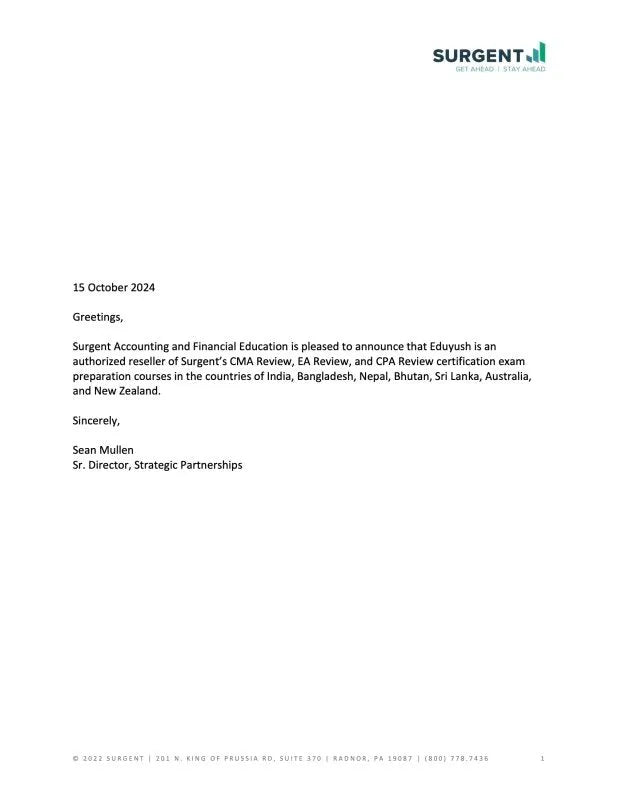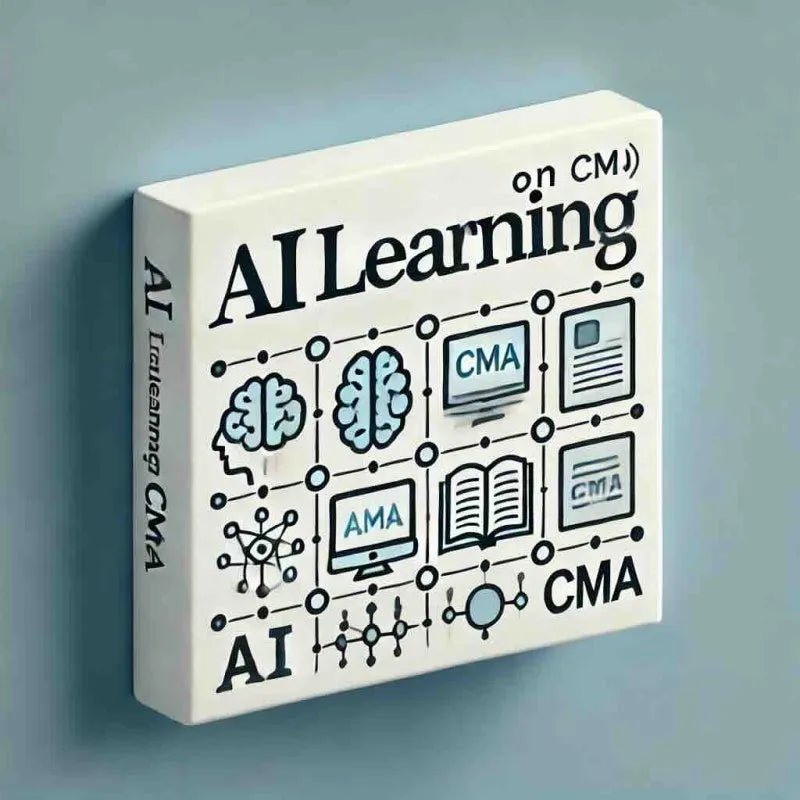How to pass CMA Part 1: Tips
How to Pass CMA Part 1: Essential Tips and Strategies
How to pass CMA Part 1 is a question that many aspiring CMAs face. The CMA Part 1 exam, Financial Planning, Performance, and Analytics, focuses on crucial financial and accounting skills. Preparing for this exam requires mastering formulas, understanding high-yield topics, and refining time management skills.
This blog will dive into strategies that will help you pass CMA Part 1 and maximize your study time.
How to pass CMA Part 1
Step 1. CMA Part 1 Exam Structure
To pass CMA Part 1, it’s essential to understand the exam’s structure. As a reminder, CMA Part 1 consists of:
- 100 MCQs: 3 hours
- 2 essay questions: 1 hour
The MCQ section usually contains:
- Conceptual and theoretical questions are often shorter and less complex.
- Computational questions require detailed calculations and can be formula-heavy.
Many candidates find that while conceptual questions may feel easier, the computational ones can be time-consuming and tricky, particularly if you lack a solid grasp of the formulas. Tackling this mix effectively requires a strategic approach.Remember, a strategic approach is the key to managing your time and performing well in the MCQ section.
You need to score at least 360 out of 500 to pass, so familiarizing yourself with CMA exam passing scores will help you target the right level of preparation.
Step 2. Understand High-Yield Topics and Formula Mastery
Specific topics in CMA Part 1 are computation-heavy and frequently tested. These high-yield areas require thorough understanding and practice with formulas.
Planning, Budgeting, and Forecasting (20%)
-
Key Formulas:
- Flexible Budgets: Be prepared to calculate variances for both static budgets and flexible budgets.
- Sales Variance: Sales volume and price variance formulas are commonly tested.
- Cost Variance: Direct material, labor, and overhead variances are central.
-
Nuanced Approach:
- Focus on variance formulas—you’ll be expected to calculate multiple variances, often within the same question.
- Practice breaking down complex budgets or forecasting questions into smaller parts rather than being overwhelmed by the overall computation.
Performance Management (20%)
-
Key Formulas:
- ROI (Return on Investment), Residual Income (RI), and EVA (Economic Value Added).
- Variance Analysis: Price, quantity, rate, and efficiency variances. These are central to MCQs and essays alike.
-
Nuanced Approach:
- These are high-yield topics, and the MCQs may involve applying multiple formulas to calculate various performance measures.
- Time management is crucial here: Some questions may require you to compute several values (e.g., ROI and RI), so get comfortable with the steps.
- Learn shortcuts and simplifications for calculating basic performance measures quickly.
Cost Management (15%)
-
Key Formulas:
- Activity-Based Costing (ABC): Be familiar with overhead rate allocation formulas.
- Job-order and Process Costing: Formulas for calculating cost per unit, equivalent production units, and overhead application rates.
-
Nuanced Approach:
- Computation-heavy MCQs often require you to allocate costs using ABC or traditional costing systems. Familiarize yourself with how to apply these formulas efficiently.
- Break complex costing problems into smaller steps—many MCQs are built this way.
External Financial Reporting Decisions (15%)
-
Key Formulas:
- Ratios: Liquidity, profitability, solvency, and efficiency ratios.
- Depreciation Methods: Be comfortable with straight-line, declining balance, and units of production depreciation.
-
Nuanced Approach:
- Ratio-based MCQs are often conceptual, but computation questions involve multiple steps (e.g., calculating multiple financial ratios).
- Memorize ratio formulas and practice computing them under time pressure, as rushed calculations can cause confusion.
Reviewing these formulas daily will prepare you for both MCQs and essay questions. Check out this guide on tackling MCQ questions effectively to deepen your understanding.
Step 3: Handling Easy vs. Hard MCQs in CMA Part 1
You’ll face a blend of easy conceptual and challenging computational questions during the exam. Here’s how to handle both:
Strategy for Easy (Conceptual) MCQs:
- Identify these questions quickly. They are usually shorter and don’t require calculations. Examples include defining terms (e.g., "What is a balanced scorecard?"), identifying components of internal controls, or asking about accounting principles.
- Answer them first: Breeze through conceptual questions confidently and save time for tougher ones.
- Don’t overthink them: Stick to what you know. If the question seems straightforward, trust your first instinct.
Strategy for Hard (Computational) MCQs:
- Read carefully: These questions often involve multiple variables and steps. Read the entire question before diving into calculations to ensure critical details.
- Write down formulas: Don’t try to calculate in your head—jot down the formula first, then substitute the values to avoid mistakes.
- Use elimination: For complex questions with several steps, you can often eliminate incorrect answer choicesafter the first calculation step. This can help save time.
- Flag and return: If the question involves several calculations and takes too long, flag it and move on. Don’t let a single tricky question eat into your time for easier MCQs
Refer to how to tackle MCQ questions for in-depth tips on mastering this section.
Step 4: How to Approach Essay Questions
The essay portion of CMA Part 1 tests your ability to apply your knowledge structured and logically. Essays often involve:
- Variance analysis
- Budgeting scenarios
- Cost calculations
Steps to approach essay questions:
- State the formula: Write the formula you’re using.
- Show calculations: Plug values into the formula and show your work.
- Explain results: Provide context for your calculations by explaining the result.
For detailed tips, read how to tackle essay questions to refine your strategy.
Step 5. Study Plan for Success
Effective time management is critical to passing CMA Part 1. Here’s a three-month study plan:
Month 1: Foundation
- Weeks 1-2: Focus on External Financial Reporting. Understand financial statements and solve ratio problems.
- Weeks 3-4: Dive into Planning, Budgeting, and Forecasting. Practice variance analysis formulas.
For Month 2: Formula Mastery
- Weeks 5-6: Focus on Performance Management. Master ROI, RI, EVA, and variance analysis.
- Weeks 7-8: Focus on Cost Management. Solve costing problems related to ABC and job-order costing.
Month 3: Mock Exams
- Weeks 9-10: Take a timed mock exam. Analyze your performance and review challenging areas.
- Weeks 11-12: Take another full-length mock exam and focus on formulas that need reinforcement.
Step 6. Tap into Additional Resources
- Formula Sheets: Create or download Eduyush formula sheets for CMA Part 1. Review them daily, especially in the weeks before the exam.
- Flashcards: Use flashcards to memorize complex formulas. Write the formula on one side and an example calculation on the other.
- Online Forums: These are not just platforms for discussion, but also for collaboration. Join CMA forums on reddit to discuss difficult computational questions and compare solutions with other candidates.
Step 7: Exam-Day Tips
- Time Management: Aim to complete the 100 MCQs in 2-2.5 hours, leaving the remaining time for essays. Don’t get stuck on any one MCQ for too long.
- Essays: Allocate about 30 minutes per essay. Answer every part of the essay question—even partial answers can get points.
- Flag Difficult MCQs: If unsure about a question, flag it and return to it later. Don’t waste time early in the exam on difficult questions.
- Use Practice Exams: Simulate exam conditions by taking at least two full-length practice exams before the actualtest.
Step 8: Additional information on how to pass CMA Part 1
CMA Exam Pass Rates
To understand your chances of passing, consider reviewing CMA exam pass rates. Historically, CMA Part 1 tends to have a lower pass rate than Part 2 due to the technical nature of the content. Focus on practice and preparation to increase your chances of success.
Choosing CMA Part 1 or Part 2 First
Taking CMA Part 1 or Part 2 first depends on your strengths. Part 1 is more technical and focuses heavily on accounting concepts like cost management and performance measurement. Part 2, on the other hand, focuses on strategic financial management. If you’re strong in accounting, starting with Part 1 makes sense. If corporate finance and decision-making are your strengths, consider tackling Part 2 first.
For more guidance, check out which CMA part to do first.
Conclusion: Key Takeaways for Passing CMA Part 1
To pass CMA Part 1 of the CMA certification, master high-yield computational topics like variance analysis, budgeting, and cost management. Utilize time management strategies to handle both MCQs and essay questions effectively. Lastly, leverage a structured study plan, ensuring you review formulas and practice questions regularly.
For a comprehensive overview of the CMA USA program, check out our detailed guide on CMA USA Course Details.
Surgent CMA Review course
Pass the CMA USA Exam with a 95% Success Rate
✅Smart, AI-Driven Study Plan for Faster Learning
✅Comprehensive Study Materials & Expert Support
✅Now Available at India pricing at 70% Off
Frequently Asked Questions About the CMA US Certification Course
What is the CMA course, and how does it differ from other accounting certifications?
The CMA US course is a globally recognized certification program for finance and accounting professionals, focusing on strategic financial management, budgeting, and performance management. It’s ideal for those looking to advance in corporate finance roles.
How difficult is the CMA exam, and what are the pass rates?
The CMA exam is known for being challenging, with an average global pass rate of around 45%. The exam consists of two parts: Part 1 focuses on Financial Planning, Performance, and Analytics, while Part 2 covers Strategic Financial Management. Each part has a mix of multiple-choice questions and essay questions, which test both theoretical knowledge and practical application. Most candidates find Part 1 more quantitative and Part 2 more strategic, with both requiring thorough preparation.
How long does it take to complete the CMA US course?
Most candidates complete the course in 6-18 months, depending on study time and preparation. The two exam parts can be scheduled separately, allowing for flexible pacing.
How long do you have to pass both parts?
CMA aspirants have three years to successfully complete both components of the exam from the day they join their program. With ample time available, success is well within reach!
How much time should I dedicate to studying for the CMA exam?
Most candidates report studying between 150 to 200 hours for each part of the CMA exam. If working full-time, this could translate to around 3-5 months per part, depending on your existing accounting knowledge and study habits. A structured study schedule, covering each section systematically and including ample time for practice questions and revision, is essential for success.
CMA resources links
Here are all the links to CMA Resources
- ACCA vs CMA
- CMA Certification
- CMA Exam Centre. Locations
- CMA US online course
- CMA Exam Dates: Complete Guide for your Test in 2025
- CMA Exam Essay Questions: How to Master Them
- CMA Exam fees. Updated for 2024
- CMA Exam High Yield Topics: Where to focus
- CMA Exam Pass Rates: Insights and Tips
- CMA Exam Passing Score: How to Pass with ease
- CMA Exam pattern: Your Complete Guide
- CMA Exam Tips: How to Pass on Your First Try in 2025
- CMA Part 1 Formula Sheet
- CMA Part 1 or Part 2: Which to Take First?
- CMA Performance report: How to Interpret Exam Scores
- CMA Study Plan: How to Master the Exam in 2025
- CMA Syllabus Changes 2025: Key Updates
- CMA US CPE requirements: Complete Guide
- CMA US Eligibility Requirements
- CMA USA Course details: Comprehensive guide
- CMA USA Results: What to Expect in 2025
- CMA vs CA: Which is Better for Your Career?
- CMA vs CPA: Choosing the Right Path for Your Career
- CMA Work Experience Requirement
What are the career prospects for CMA holders, and how does it impact salary?
The CMA credential can open doors to various managerial and executive positions in finance, accounting, and corporate management. Common roles include financial analyst, management accountant, CFO, and financial controller. Salary expectations vary by region, but CMAs generally earn around 30-50% more than their non-certified peers. In the U.S., the average salary for CMAs can range from $80,000 to $150,000 annually, depending on experience and location.
Can I pursue the CMA certification while working full-time?
Yes, many candidates complete the CMA while working full-time. Time management is crucial, and it may involve studying during evenings and weekends. Employers often support CMA candidates by providing study resources, financial assistance, or time off for exam preparation. Reddit users recommend setting realistic goals and maintaining a consistent study routine to balance work and study effectively.
How is the CMA viewed outside the United States?
The CMA is recognized in over 100 countries and is highly regarded in various industries, particularly in regions like the Middle East, China, and India. It is especially valuable for professionals interested in multinational corporations or companies with a global presence. In some countries, CMA-certified professionals may earn equivalent or even higher salaries than CPAs or local accounting professionals.
Is the CMA course worth it if I already have a CPA or another accounting certification?
Many professionals with a CPA or another accounting certification pursue the CMA to gain expertise in management accounting and strategic decision-making. The two credentials can complement each other well, with the CPA focusing more on auditing and tax and the CMA emphasizing corporate finance and strategy. The choice depends on career goals—if you're aiming for managerial roles in corporate finance, the CMA is highly advantageous.
How is the job market for CMAs affected by automation and AI?
While automation and AI have affected traditional accounting roles, they have increased the demand for management accountants who can interpret data and contribute to strategic decision-making. CMAs are well-positioned to leverage these technologies, as their training covers data analytics and performance management, making them valuable assets in organizations seeking to innovate and optimize processes.
What happens if I fail a part of the CMA exam?
If you fail a part of the CMA exam, you can retake it during the next testing window. The IMA offers the exam in three testing windows each year: January-February, May-June, and September-October. Preparing for a retake may involve identifying areas of weakness, revising study materials, and perhaps trying different resources or study methods.
Who is eligible for the CMA US course?
To be eligible, candidates must have a bachelor’s degree from an accredited institution, two years of relevant professional experience in financial or management accounting, and IMA membership.













Leave a comment